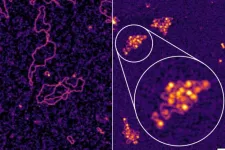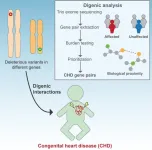(Press-News.org) Scientists have discovered a potentially greener way to produce a crucial industrial chemical used to make many everyday products from plastics and textiles to antifreeze and disinfectants, according to a new study published in Science and co-authored by Tulane University chemical engineer Matthew Montemore.
The breakthrough could significantly reduce greenhouse gas emissions from the manufacture of ethylene oxide, which has an estimated $40 billion global market. The current production process requires chlorine, which is toxic and emits millions of tons of carbon dioxide into the atmosphere annually.
The research team, led by Montemore, as well as Tufts University chemistry professor Charles Sykes and University of California Santa Barbara (UCSB) chemical engineering professor Phillip Christopher, found that adding small amounts of nickel atoms to silver catalysts can maintain production efficiency while eliminating the need for chlorine in the process.
“If industry does try this out and they find it to be useful and are able to commercialize it, the twin benefits are you can save a lot of CO2 and a lot of money at the same time,” Montemore said.
Getting rid of toxic chlorine could also make production safer, Montemore added.
The discovery was six years in the making. Sykes and Montemore first discussed exploring selective oxidation reactions in 2018. They focused on ethylene oxide production, which converts ethylene and molecular oxygen using silver as the primary catalyst.
"We were surprised because we couldn't find anything in the scientific or patent literature about nickel despite it being a common and inexpensive element used in many other catalytic processes," Sykes said.
The breakthrough came through applying Sykes' single-atom alloy concept, a fundamental approach to understanding and controlling chemical reactions that he pioneered over a decade ago. Montemore thought this approach could be applied to oxidation reactions, even though Sykes had not had much success with oxidation in the past.
Montemore performed calculations to screen for promising combinations of metals. Based on these calculations, PhD students Elizabeth Happel and Laura Cramer at Tufts conducted initial experiments that showed promising results.
The team then enlisted Christopher, an expert on catalytic reactor studies, to develop a practical formulation of the silver catalyst with nickel additions.
The results exceeded expectations.
Anika Jalil, a doctoral student at UCSB successfully developed a reproducible method for incorporating nickel atoms into the silver catalyst, a technical challenge that may explain why this effect had never been previously reported.
The current industrial process for producing ethylene oxide typically generates two molecules of carbon dioxide per ethylene oxide molecule. Adding chlorine improves this ratio to about two molecules of ethylene oxide per carbon dioxide molecule. The new nickel-enhanced catalyst could potentially reduce these emissions further while eliminating the need for toxic chlorine in the process.
The team has submitted international patents for their discovery and is in discussions with a major commercial producer about implementing the technology in existing manufacturing facilities.
If successful, this cleaner production method could help address the significant environmental impact of ethylene oxide manufacturing while maintaining the efficiency needed for industrial-scale production.
END
Chemists find greener path to making key industrial chemical
2025-02-20
ELSE PRESS RELEASES FROM THIS DATE:
Giant X-ray facility shows that magnets can reduce flaws in 3D printed components
2025-02-20
Safety critical components for aircraft and Formula 1 racing cars could one day be 3D printed via a new technique, developed by researchers at UCL and the University of Greenwich, that substantially reduces imperfections in the manufacturing process.
The technique was developed after the team used advanced X-ray imaging to observe the causes of imperfections that formed in complex 3D printed metal alloy components. If this technique becomes widely deployed it could make a range of these components, from artificial hip joints to aircraft parts, stronger and more durable.
The study, published in Science, observes the forces at play during ...
Cooling materials – Out of the 3D printer
2025-02-20
Rapid, localized heat management is essential for electronic devices and could have applications ranging from wearable materials to burn treatment. While so-called thermoelectric materials convert temperature differences to electrical voltage and vice versa, their efficiency is often limited, and their production is costly and wasteful. In a new paper published in Science, researchers from the Institute of Science and Technology Austria (ISTA) used a 3D printing technique to fabricate high-performance thermoelectric materials, reducing production costs significantly.
Thermoelectric coolers, also called solid-state ...
New knowledge portal adiposetissue.org enhances obesity and metabolism research with centralized data
2025-02-20
Addressing the Challenge of Dispersed Data
For years, adipose tissue research has generated vast amounts of omics data, but these datasets remained scattered across different repositories, making comprehensive analysis challenging. Adiposetissue.org now brings insights together, integrating transcriptomic and proteomic with clinical data from more than 6,000 individuals, enabling researchers to explore obesity-related changes, weight-loss effects, and cellular mechanisms with unprecedented depth.
“We developed ...
Study suggests new molecular strategy for treating fragile X syndrome
2025-02-20
Building on more than two decades of research, a study by MIT neuroscientists at The Picower Institute for Learning and Memory reports a new way to treat pathology and symptoms of fragile X syndrome, the most common genetically-caused autism spectrum disorder. The team showed that augmenting a novel type of neurotransmitter signaling reduced hallmarks of fragile X in mouse models of the disorder.
The new approach described in Cell Reports works by targeting a specific molecular subunit of “NMDA” receptors that they discovered plays a key role in how neurons synthesize ...
Digging into a decades-old hepatitis B mystery suggests a new potential treatment
2025-02-20
In their effort to answer a decades-old biological question about how the hepatitis B virus (HBV) is able to establish infection of liver cells, research led by Memorial Sloan Kettering Cancer Center (MSK), Weill Cornell Medicine, and The Rockefeller University identified a vulnerability that opens the door to new treatments.
The team successfully disrupted the virus’s ability to infect human liver cells in the laboratory using a compound already in clinical trials against cancer — laying the ...
Big birds like emus are technical innovators, according to University of Bristol researchers
2025-02-20
Large birds – our closest relations to dinosaurs - are capable of technical innovation, by solving a physical task to gain access to food.
This is the first time scientists have been able to show that palaeognath birds such as emus and rheas can solve tricky problems.
In the study, published today in Scientific Reports, emus, which have previously been called the ‘world’s dumbest bird’ were able to create one new technique to access food (lining up a hole with a food chamber) and moved the hole in the most efficient direction towards food in 90% of cases. A male rhea ...
Hidden genetic causes of congenital heart disease identified
2025-02-20
New York, NY [February 20, 2025]—Scientists at the Icahn School of Medicine at Mount Sinai and collaborators have identified novel genetic interactions that may contribute to congenital heart disease (CHD), a common birth defect. Details on their findings were reported in the February 20 online issue of The American Journal of Human Genetics [DOI: 10.1016/j.ajhg.2025.01.024].
“Our research reveals the potential for digenic inheritance—where two genes work together to cause disease—expanding our understanding of the genetic underpinnings of congenital heart ...
Semaglutide and nonarteritic anterior ischemic optic neuropathy
2025-02-20
About The Study: The results of this study suggest a modest increase in the risk of nonarteritic anterior ischemic optic neuropathy among individuals with type 2 diabetes associated with semaglutide use, smaller than that previously reported, and warranting further investigation into the clinical implications of this association.
Corresponding Author: To contact the corresponding author, Cindy X. Cai, MD, MS, email ccai6@jhmi.edu.
To access the embargoed study: Visit our For The Media website at this link https://media.jamanetwork.com/
(doi:10.1001/jamaophthalmol.2024.6555)
Editor’s ...
Inequities in the application of behavioral flags for hospitalized pediatric patients
2025-02-20
About The Study: This cohort study found significant inequities in incidence of behavioral flags in the electronic health record among racially and socioeconomically marginalized pediatric patients. This finding was most pronounced for Black or African American patients younger than 8 years, suggesting that this phenomenon may be a response to Black families rather than specific patient behavior.
Corresponding Author: To contact the corresponding author, April Edwell, MD, MAEd, email April.edwell@ucsf.edu.
To access the embargoed study: Visit our For The Media website at this link https://media.jamanetwork.com/
(doi:10.1001/jamanetworkopen.2024.61079)
Editor’s ...
Paxlovid’s impact on hospitalization and death in COVID-vaccinated older adults far weaker than previously thought
2025-02-20
Paxlovid does not significantly reduce COVID-19 hospitalization and mortality among vaccinated older adults, according to new UCLA-led research.
The study questions the assumption that Paxlovid’s effectiveness in reducing COVID-19 hospitalizations and deaths in unvaccinated adults also applies to vaccinated adults. Pfizer’s 2022 clinical trial found reduced COVID-19 hospitalization in unvaccinated middle-aged adults; while a subsequent 2024 clinical trial found no significant reduction in vaccinated middle-aged adults. Since most older Americans have already received two or more COVID-19 vaccines, Paxlovid’s effectiveness on vaccinated ...





